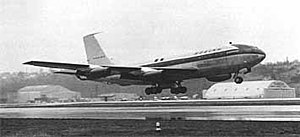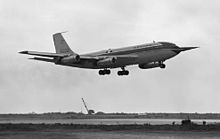Boeing 367-80
| Boeing 367-80 | |
|---|---|

| |
| Boeing 367-80 (N70700) prototype in a NASA archive photo | |
| Role | Prototype transport/airliner |
| Manufacturer | Boeing |
| First flight | July 15, 1954 |
| Introduction | 1954 |
| Retired | 1969 |
| Produced | 1954 |
| Number built | 1 |
| Career | |
| Owners and operators | Boeing |
| In service | 1954–1969 |
| Fate | Retired |
| Preserved at | Steven F. Udvar-Hazy Center |
The Boeing 367-80, or "Dash 80" as it was called within Boeing, is an American prototype jet transport built to demonstrate the advantages of jet aircraft for passenger transport over piston-engined airliners.[1]
The Dash 80 is considered to have been the prototype for the KC-135 Stratotanker aerial refuelling tanker and the Boeing 707 airliner. It was built in less than two years from project launch in 1952 to rollout on May 14, 1954 for a cost of US$16 million. This was at the time an enormous risk for the Boeing Company, since they had no committed customers for the project.
Only one example of the type was built which exists today in the Steven F. Udvar-Hazy Center, an annex of the Smithsonian Institution's National Air and Space Museum located at Washington Dulles International Airport, Virginia, United States.
Design and development
By the late 1940s, two developments were encouraging Boeing to begin considering the possibility of building a passenger jet.
The first was the maiden flight in 1949 of the world’s first jet airliner, the de Havilland Comet. With its 500 mph (800 km/h) cruise speed, it promised to significantly reduce journey times compared with existing propeller-powered aircraft. Boeing President Bill Allen led a company delegation to Britain in summer 1950 where they saw the Comet fly at the Farnborough Airshow, and also visited the de Havilland factory at Hatfield, Hertfordshire where the Comets were being built.
The second event was completion by 1950 of successful development of the B-47 Stratojet. Boeing felt that this program had enabled it to master the swept wing and podded engines which it saw as key technologies that would enable it to improve on both the performance and the engine maintenance of the Comet.
In 1950, Boeing tentatively produced a specification for a jet airliner which it dubbed the Model 473-60C.[2] However the airlines were unconvinced[3] because they had no experience with jet transports, and were enjoying success with piston engined aircraft such as the Douglas DC-4, DC-6, Boeing 377 and Lockheed Constellation.
There was also a broader problem: Boeing was experienced at selling to the military, but had not enjoyed the same success with civil airliners. This market was dominated by Douglas who was adept at meeting the needs of airlines by refining and developing its range of propeller-driven aircraft, and in 1950 were actively marketing the forthcoming DC-7. Boeing decided that the only way to overcome the airlines' suspicion of the jet - and of itself - was to show them a completed aircraft.[4]
As the first of a new generation of passenger jets, Boeing wanted the aircraft's model number to emphasize the difference from its previous propeller-driven aircraft which bore 300-series numbers. The 400-, 500- and 600-series were already used by missiles and other products, so Boeing decided that the jets would bear 700-series numbers, and the first would be the 707.[5] However, just after the program was approved, Boeing changed the designation as a disinformation tactic intended to mislead its competitors. "367" was the Boeing model number of the KC-97 Stratotanker, a previous generation aircraft to which the Dash 80 owed nothing.[3] although it did have the same 132 in (3.33m) fuselage diameter as the 367s and the 367s fuselage crease was smoothed out.[1] Although the design was announced as the Model 707 the prototype was referred to simply as the "-80", or Dash 80.
The -80 fuselage was wide enough for five-abreast seating; two on one side of the aisle and three on the other. However, by the time the Boeing company committed to production, the decision had been made to design the production model 707 as a six-abreast design, with a larger-diameter fuselage 148 in (3.76 m), based on feedback from airline officials who had studied the prototype. This decision did not unduly delay introduction of the production model since the -80 had been largely handbuilt, and thus little production tooling had been created for its manufacture.[6]
Operational history
By early 1952, the designs were complete, and in April 1952, the Boeing board approved the program to build the jet. Construction of the Dash 80 took started in November in a walled-off section of Boeing's Renton, Washington plant.[7]. As a proof of concept prototype there was no certification and no production line and most of the parts were custom built. The aircraft's interior was not fitted with an airline cabin; rather it consisted of a basic plywood lining that was used to house the test instrumentation required for the flight test program.
The Dash 80 was rolled out of the factory on May 15, 1954, just two years after the project was approved, and 18 months after construction had started.[8] The 367-80 then undertook a series of taxi trials and although the port landing gear collapsed on May 22 causing damage to the airframe which was quickly repaired,[1] the maiden flight took place on July 15, 1954.
A series of test flights followed during which the most significant issue discovered was a marked propensity to "Dutch roll" - an alternating yawing and rolling motion. Boeing already had considerable experience with this on the B-47 and B-52, and had developed a yaw damper system on the B-47 that could be adapted to later swept wing configurations like the Dash 80. Other problems were found with the engines and brakes, the latter failing completely during landing on one occasion causing the aircraft to overshoot the runway and suffer damage.[9]

In addition to the flight testing program, Boeing also used the Dash 80 to provide demonstration flights to airline executives and other key industry figures. These focused attention on the question of what the cabin of a passenger jet should look like. In a significant departure from its usual practice, Boeing hired industrial design firm Walter Dorwin Teague to create a cabin as radical as the aircraft itself.[10]
The barrel roll
As part of the Dash 80's demonstration program, Bill Allen invited representatives of the Aircraft Industries Association (AIA) and International Air Transport Association to the Seattle's 1955 Seafair and Gold Cup Hydroplane Races held on Lake Washington on August 6, 1955. The Dash-80 was scheduled to perform a simple flyover, but Boeing test pilot Alvin "Tex" Johnston instead performed a barrel roll to show off the jet airliner.[11]
The next day, Allen summoned Johnston to his office and told him not to perform such a maneuver again, notwithstanding Johnston's assertion that doing so was completely safe ("It's a one-g maneuver. It's absolutely nonhazardous, but it's very impressive," explained Johnson to Allen)[12].
To date the only other four engine jet transport aircraft known to have been rolled is Concorde which was extensively rolled during testing by both British and French test-pilots[citation needed]. Other big four engine jet aircraft have done barrel rolls; for instance, the Avro Vulcan XA890 was rolled by Roly Falk on the first day of the 1955 Farnborough Airshow[13], but it was a bomber. The barrel roll story appears on a video called Frontiers of Flight - The Jet Airliner, produced by the National Air and Space Museum in association with the Smithsonian Institution in 1992.[11]
The legacy of the 707 barrel roll lives on: Boeing Chief Test Pilot John Cashman has stated that just before he piloted the maiden flight of the Boeing 777 on June 12, 1994, his last instructions from then-Boeing President Phil Condit were "No rolls."[14]
Life as an experimental aircraft
After the arrival of the first production 707 in 1957, the Dash 80 was adapted into a general experimental aircraft and used by Boeing to test a variety of new technologies and systems. One of its most important tasks during the late 1950s was to test systems for the new Boeing 727. These tests required the fitting of a fifth engine on the rear fuselage to simulate the 727's third engine.[citation needed]
Other tests included experiments with different airfoil shapes and a number of high lift devices such as blown flaps in which compressed air bled from the engines is directed over the flaps to increase lift during takeoff and landing.[3]
Final flight

After 2,350 hours and 1,691 flights the aircraft was withdrawn from use in 1969 and placed in storage.[15] On May 26, 1972 Boeing donated the 367-80 to the Smithsonian Air and Space Museum, the museum had designated it one of 12 most significant aircraft of all time.[15] For the next 18 years the aircraft was stored at an Aircraft boneyard in Arizona before being returned to Boeing in 1990 for restoration. The Dash 80's final flight was to Dulles International Airport near Washington, D.C. on August 27, 2003. She was put on display at the Steven F. Udvar-Hazy Center, an annex of the Smithsonian Institution's National Air and Space Museum, located adjacent to Dulles Airport in Chantilly, Virginia.[16]
Specifications (367-80)
General characteristics Performance
- Thrust/weight: 0.3:1
See also
Related development
Aircraft of comparable role, configuration, and era
References
- Notes
- ^ a b c Pither 1998, p. 12.
- ^ Irving 1994, p. 166.
- ^ a b c "Boeing 367-80." National Air and Space Museum, (Smithsonian Institution, 2004. Retrieved: February 22, 2007.
- ^ Irving 1994, pp. 167–169.
- ^ Irving 1994, p. 171.
- ^ Boeing web page
- ^ "Dash 80 The story of the prototype 707". R.G. Thompson. Air & Space Magazine. May 1, 1987. Retrieved 9 August 2009.
- ^ Irving 1994, p. 173.
- ^ Irving 1994, p. 179.
- ^ Boeing's relationship with Walter Dorwin Teague has continued to the present day.
- ^ a b Video interview with Tex Johnston about barrel roll
- ^ "It's Possible to Roll This Airplane." Flying Magazine, Vol. 135, No. 5, May 2008, p. 48.
- ^ Laming 2002, p. 48.
- ^ Wallace, James. "After 40 years at Boeing, chief test pilot John Cashman is retiring." seattlepi.nwsource.com, January 12, 2007. Retrieved: April 4, 2009.
- ^ a b Pither 1998, p. 13.
- ^ "Historic Boeing Dash 80 Aircraft Makes Final Flight to Dulles for Display at National Air and Space Museum's Companion Facility, the Steven F. Udvar-Hazy Center". Smithsoneon Institute. Retrieved 2009-04-05.
- Bibliography
- Bowers, Peter M. Boeing aircraft since 1916. London: Putnam Aeronautical Books, 1989. ISBN 0-85177-804-6.
- Irving, Clive. Wide Body: The Making of the Boeing 747. Philadelphia: Coronet, 1994. ISBN 0-340-59983-9.
- Laming, Tim. The Vulcan Story 1952-2002, Second Edition. Enderby, Leicester, UK: Silverdale Books, 2002. ISBN 1-85605-701-1.
- Tony Pither. The Boeing 707 720 and C-135. Tunbridge Wells, Kent, UK: Air-Britain (Historians) Ltd, 1998. ISBN 0-85130-236-X
- Wilson, Stewart. Airliners of the World. Fyshwick, Australia: Aerospace Publications Pty Ltd., 1999. ISBN 1-875671-44-7.
